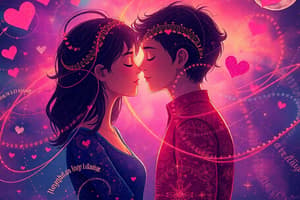Podcast
Questions and Answers
Which color is often associated with the passionate expression of love?
Which color is often associated with the passionate expression of love?
- Blue
- Red (correct)
- Yellow
- Green
The concept of 'love languages' was developed by Dr. Gary Chapman.
The concept of 'love languages' was developed by Dr. Gary Chapman.
True (A)
Name any two of the five love languages defined by Dr. Gary Chapman.
Name any two of the five love languages defined by Dr. Gary Chapman.
Words of Affirmation, Acts of Service
The primary love language that involves physical closeness is called ______.
The primary love language that involves physical closeness is called ______.
Match the love languages with their definitions:
Match the love languages with their definitions:
What effect can understanding love languages have on a relationship?
What effect can understanding love languages have on a relationship?
According to the content, the color blue represents anger in the context of love.
According to the content, the color blue represents anger in the context of love.
What are two interpretations of the 'color of love' mentioned in the content?
What are two interpretations of the 'color of love' mentioned in the content?
The love language that emphasizes spending time together is called ______.
The love language that emphasizes spending time together is called ______.
Which of the following is not one of the five love languages?
Which of the following is not one of the five love languages?
Flashcards are hidden until you start studying
Study Notes
Sexual Orientation and Identity
- Sexual Orientation: An enduring pattern of emotional, romantic, and/or sexual attractions to men, women, or both sexes.
- Sexual Identity: How individuals perceive and label themselves based on their attractions and experiences.
- Diverse Identities: Includes Pansexual, Bisexual, Asexual, Queer, Graysexual, and Skoliosexual.
Prevalence of Sexual Orientation
- Majority Heterosexual: Over 90% of the population identifies as heterosexual.
- LGBTQ+ Statistics: About 2% to 10% identify as gay or lesbian; 1% to 5% are bisexual; other identities make up approximately 1%.
Kinsey’s Sexual Orientation Scale
- Developed by Alfred Kinsey: Ranges from 0 (exclusively heterosexual) to 6 (exclusively homosexual) to illustrate sexual fluidity.
Theoretical Views on Sexual Orientation
- Psychoanalytic Views: Evolved from Freud’s theories, considering various influences on sexual orientation.
- Learning Theories:
- Behaviorism:
- Classical Conditioning: Sexual orientation may be learned through repeated associations.
- Operant Conditioning: Reinforcement can shape preferences.
- Social Learning Theory:
- Observing role models influences behavior and potential sexual orientation.
- Social reinforcement affects behaviors through acceptance/rejection.
- Cognitive Developmental Theory: Gender schemas develop that influence sexual orientation.
- Behaviorism:
Critiques of Learning Theories
- Reductionism: Oversimplification of the complex factors impacting sexual orientation development.
- Empirical Support: Limited evidence directly connects learning processes to sexual orientation.
Social Constructionist View
- Flexible Nature: Emphasizes the fluid and dynamic aspects of sexual orientation shaped by social and cultural contexts.
Biological and Neurological Models
- Focus on genetic, hormonal, brain structure, and neurotransmitter influences on sexual orientation.
Exotic Becomes Erotic Theory
- Suggests novelty in traits influences sexual attraction, reflecting the fluidity of orientation while avoiding objectification.
Female Fecundity Hypothesis
- Proposes that male homosexuality genes enhance reproductive success in female relatives, explaining genetic diversity.
Sexual Fluidity
- Suggests sexual orientation can change over time due to life experiences and emotional connections, challenging binary definitions.
Commonalities and Differences in Relationships
- Similarities: All relationships navigate trust, communication, and milestones like marriage and parenting.
- Differences: Societal prejudices, legal rights disparities, and distinct experiences of discrimination concerning sexual orientation.
Homophobia
- Defined as fear or aversion towards different sexual orientations and can manifest across various contexts (internal, interpersonal, institutional, cultural).
- Link between repressed homosexual desires and homophobic attitudes highlighted by psychological theories.
Attraction
- Complexity: Influenced by biological, psychological, social, and cultural factors, vital for forming relationships.
- Biological Influences:
- Olfactory Processes: Role of smell in attraction, impacting interactions and social connections.
- Pheromones: Chemical signals that influence subconscious attraction.
- Genetic Compatibility: Preference for mates with different major histocompatibility complex (MHC) genes.
- Sweaty T-Shirt Studies: Emphasize the role of scent in mate selection linked to genetic diversity.
Hormones and Sweat Indicators
- Hormones in sweat can signal physiological states, potentially influencing attraction and reproductive behaviors.
Taste and Its Role
- Taste Sensation: Influences food choices and social behaviors, impacting health and nutrition.
Aphrodisiacs
- Substances believed to enhance sexual desire, varying from scientifically supported to traditional beliefs.
Voice Cues
- Elements of vocal communication, such as tone and pitch, convey additional layers of meaning and influence attraction.
Limbal Rings
- Dark rings around the iris associated with youth and health, influencing perceptions of attractiveness.
Oxytocin
- Role in Social Bonding: Known as the "love hormone", vital for relationship formation and emotional connections.
- Functions: Influences reproduction, childbirth, stress reduction, and behavioral responses through receptor binding.
The Halo Effect
- A cognitive bias where a positive impression in one area influences perceptions in others, impacting social judgments and evaluations.
Summary
- Understanding sexuality encompasses numerous biological, psychological, and social factors which affect human relationships, attraction, and identity development. Each theory presents unique perspectives on the complexities surrounding sexual orientation and attraction.### Understanding Oxytocin and Its Roles
- Oxytocin plays a crucial role in human physiology and behavior, influencing bonding and attachment.
Psychosocial Determinants of Attraction
- Homophily: The tendency to connect with similar others across various dimensions:
- Demographic: Similarity in age, race, or gender.
- Value: Similar beliefs and attitudes.
- Status: Similar social standing and income.
Interpersonal Marketplace
- Interpersonal Marketplace: Social and economic dynamics where relationships are formed based on perceived mutual benefits.
- Influences the formation of social networks that tend to be homogeneous due to homophily.
Equity and Social Exchange
- Equity Theory: Suggests individuals seek fairness in relationships; perceived inequity can result in distress and lead to adjustments.
- Social Exchange Theory: Indicates social behavior results from an exchange process aiming to maximize benefits while minimizing costs; key concepts include:
- Reciprocity: Expectation of mutual benefit.
- Comparison Level: Evaluates desirability in relationships.
- Comparison Level for Alternatives: Assesses potential other relationships.
Propinquity in Relationships
- Propinquity: Refers to physical or psychological closeness essential for forming social connections.
- Types:
- Physical: Geographic proximity increases relationship likelihood.
- Psychological: Similar interests and values enhance connections.
- Types:
- Propinquity Effect: The tendency to form bonds with frequent encounters, driven by:
- Mere Exposure Effect: Familiarity leads to increased liking.
- Interaction Opportunities: Increased chances for communication.
- Shared Experiences: Common environments foster connections.
Gain-Loss Principle
- Introduced by Aronson and Linder, explains how changes in someone's attitude affect feelings towards them:
- Gain: Increased liking from changing negative to positive behavior.
- Loss: Decreased liking from changing positive to negative behavior.
- Cognitive Dissonance drives updates in feelings due to conflicting attitudes.
Misattribution of Arousal
- Physiological Arousal results from stimuli such as fear or excitement.
- Cognitive Labeling: Emotions are formed through arousal coupled with contextual interpretation.
- Classic study (Suspension Bridge Experiment) demonstrated how fear-induced arousal can be misattributed to romantic attraction.
Scarcity Principle
- Emphasizes how perceived limitations impact decisions and behaviors, affecting market dynamics and human interactions.
Neurological Models of Love
- Neurotransmitters and Hormones: Key elements in love:
- Dopamine: Generates feelings of pleasure during romantic love.
- Oxytocin: Promotes attachment and trust through physical bonding.
- Vasopressin: Associated with long-term commitment.
- Serotonin: May decrease, leading to obsessive thoughts in early love.
- Brain Regions: Certain areas (VTA, Caudate Nucleus) are linked to the experiences of romantic love.
- Stages of Love: Consists of Lust (driven by sex hormones), Attraction (involving dopamine), and Attachment (involving bonding hormones).
Sternberg’s Triangular Theory of Love
- Consists of three components: intimacy, passion, and commitment, which can create different love experiences.
Love Maps
- Introduced by John Gottman, Love Maps: Knowledge partners have about each other’s inner worlds, crucial for enhancing emotional connection and conflict resolution.
Attachment Styles
- Attachment Styles:
- Secure: Comfortable with intimacy; effective communication.
- Anxious-Preoccupied: Overly dependent; seeks validation.
- Dismissive-Avoidant: Values independence; emotionally distant.
- Fearful-Avoidant: Desires closeness yet fears intimacy.
- Impact on Relationships: Secure styles lead to healthier relationships, while insecure styles can lead to challenges and instability.
Colors of Love
- Symbolic interpretations of love through colors:
- Red: Passion and desire.
- Pink: Affectionate and gentle love.
- White: Purity and innocence.
- Yellow: Friendship and joy.### Color Interpretations and Their Meanings
- Yellow: Bright, cheerful color representing happiness and warmth.
- Blue: Symbolizes trust, loyalty, and deep emotional connections, often linked to calmness and stability in relationships.
- Green: Represents growth, harmony, and balance in love, signifying renewal and the nurturing nature of relationships.
Cultural Interpretations of Colors in Love
- Western Cultures: Predominantly view red as the color of romantic love, especially during occasions like Valentine's Day.
- Eastern Cultures: In some Asian societies, red symbolizes good fortune and joy, frequently used in weddings and festive celebrations.
Psychological Perspectives on Color
- Color Psychology: Suggests that colors can influence mood and emotions.
- Red's Effect: Associated with passionate love, studies indicate it can increase heart rate and create urgency.
Artistic Expressions of Love Through Color
- Visual Arts: Artists utilize color palettes in paintings to evoke feelings of love, passion, or tranquility.
- Literature: Authors employ color metaphors to enhance the emotional depth in narratives about love.
The Multifaceted Concept of Love
- The "color of love" varies across cultural, psychological, and personal interpretations, highlighting how colors like red and blue can express diverse dimensions of love.
Love Languages
- Concept introduced by Dr. Gary Chapman in "The 5 Love Languages: The Secret to Love That Lasts."
- Love is expressed and experienced in five primary ways, enhancing communication and relationship strength:
- Words of Affirmation
- Acts of Service
- Receiving Gifts
- Quality Time
- Physical Touch
Studying That Suits You
Use AI to generate personalized quizzes and flashcards to suit your learning preferences.




